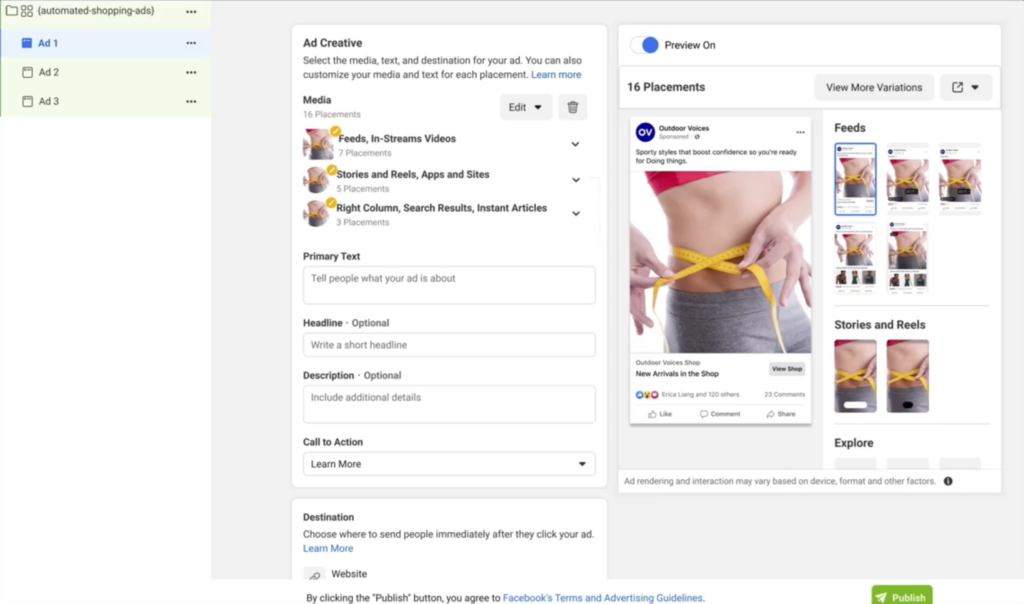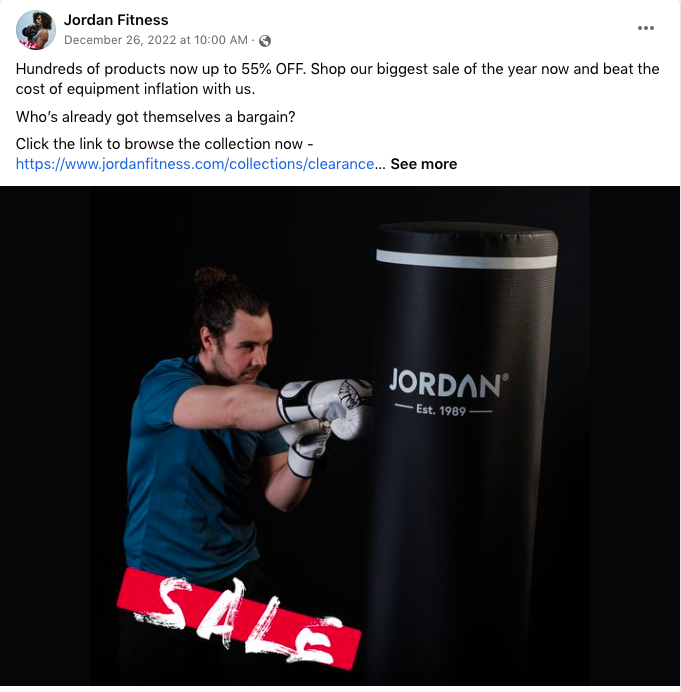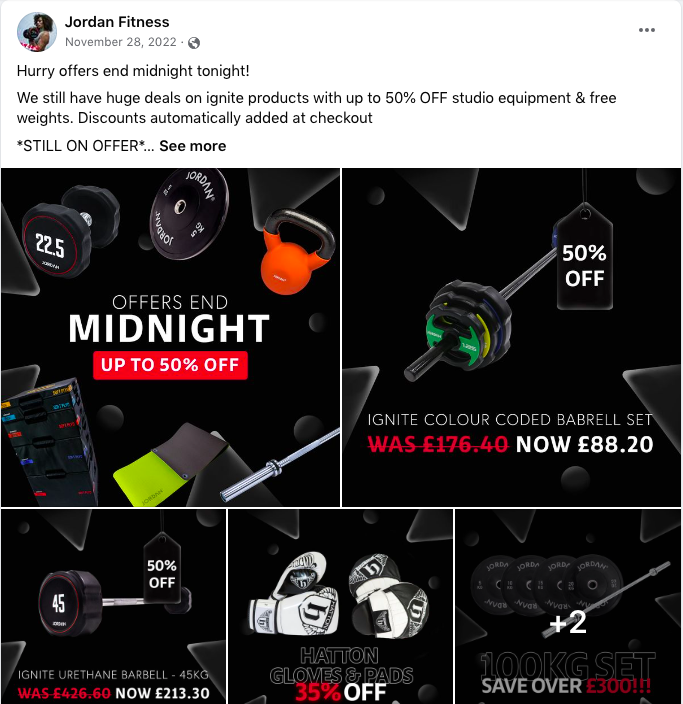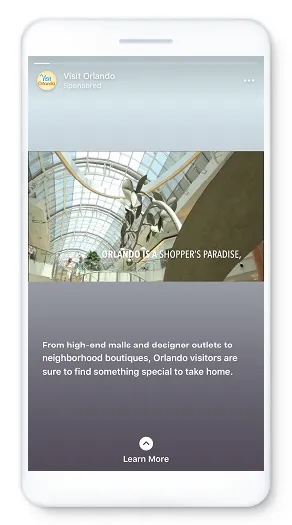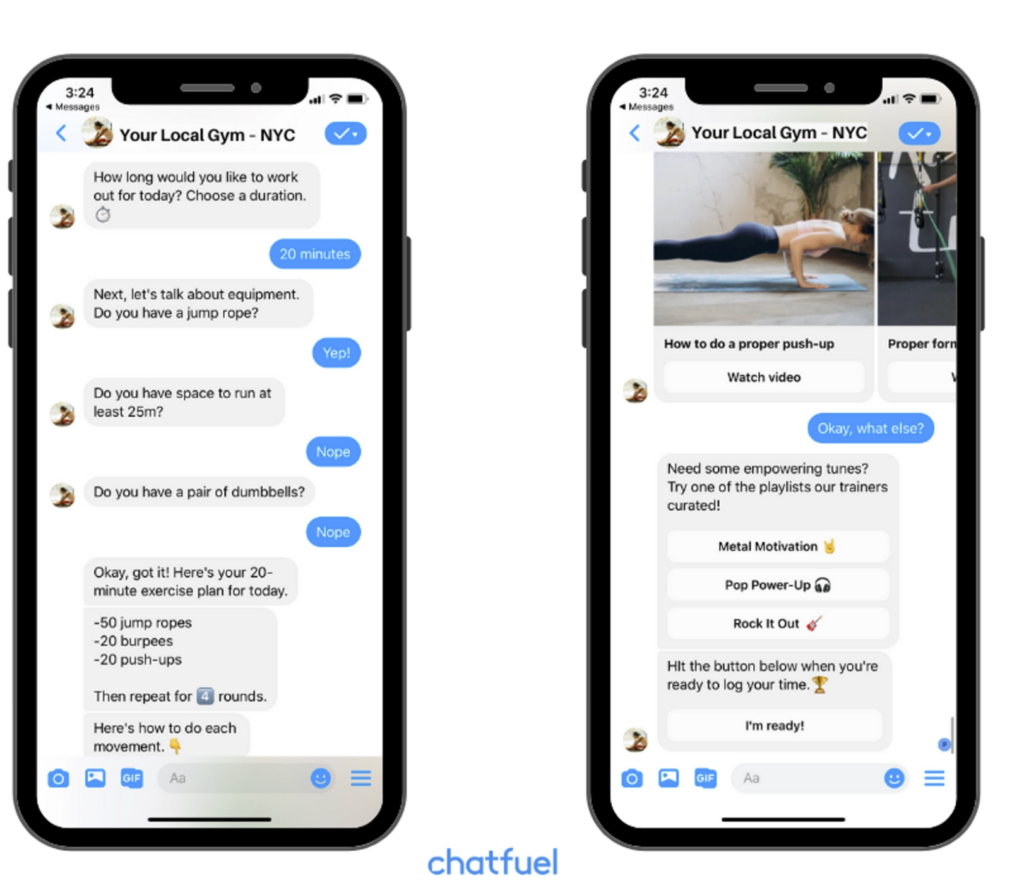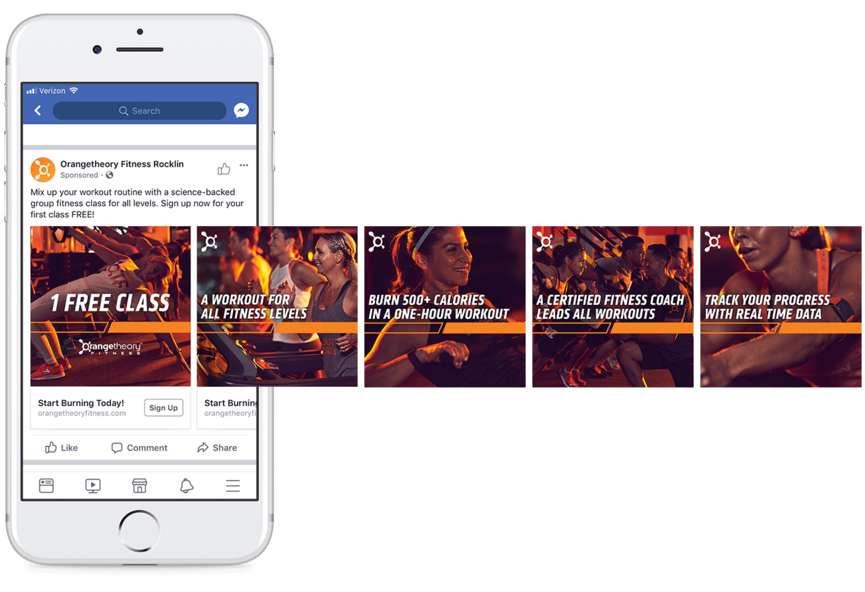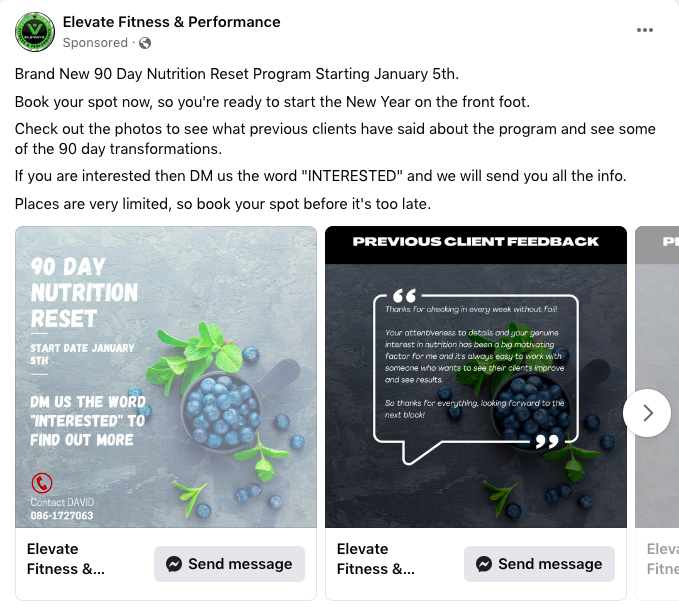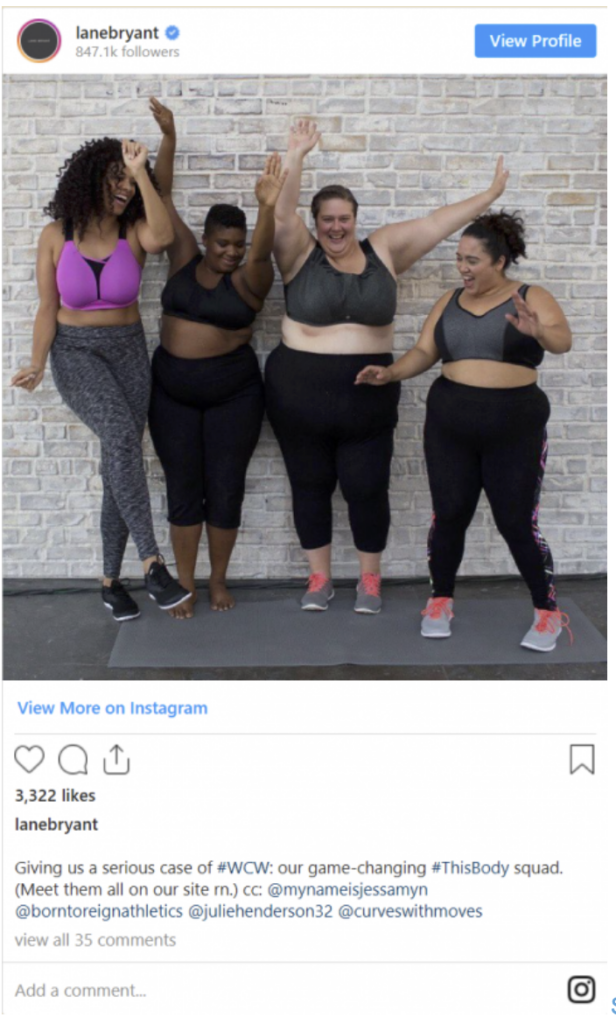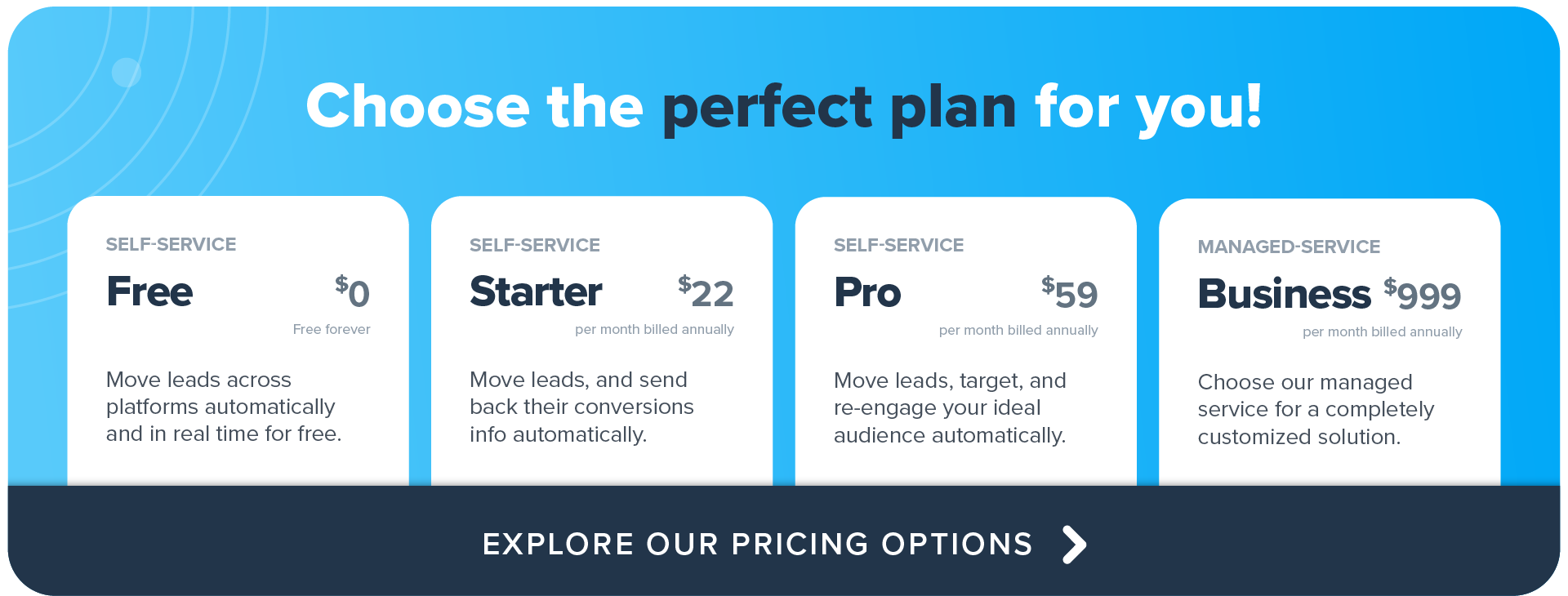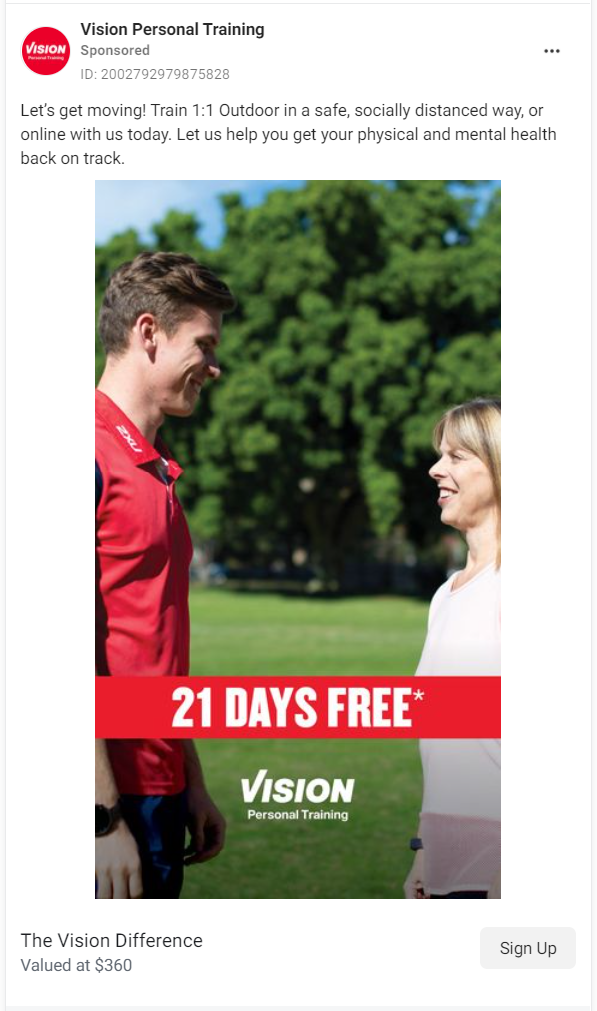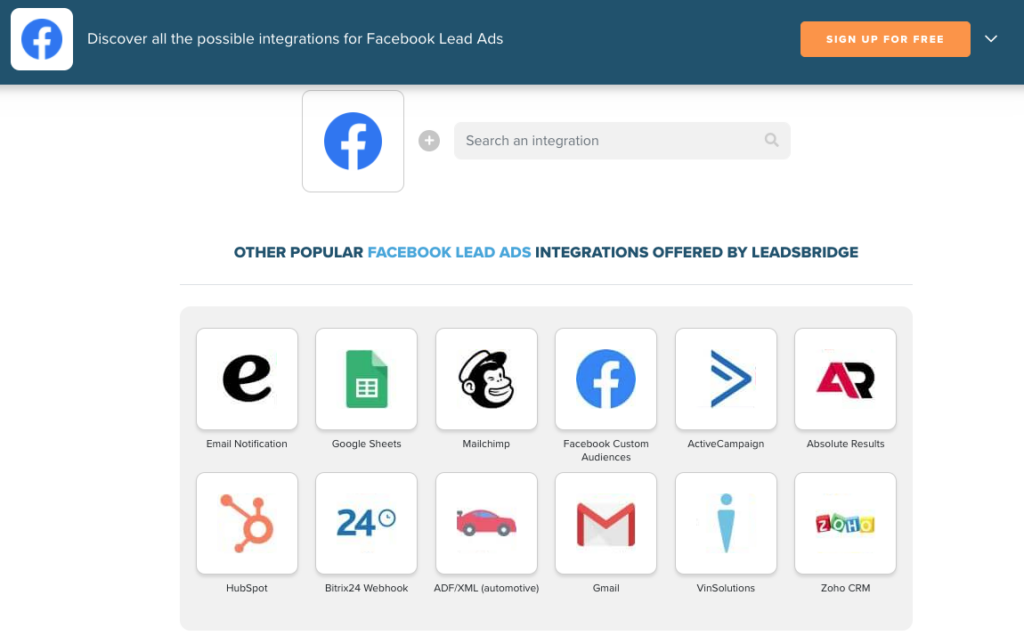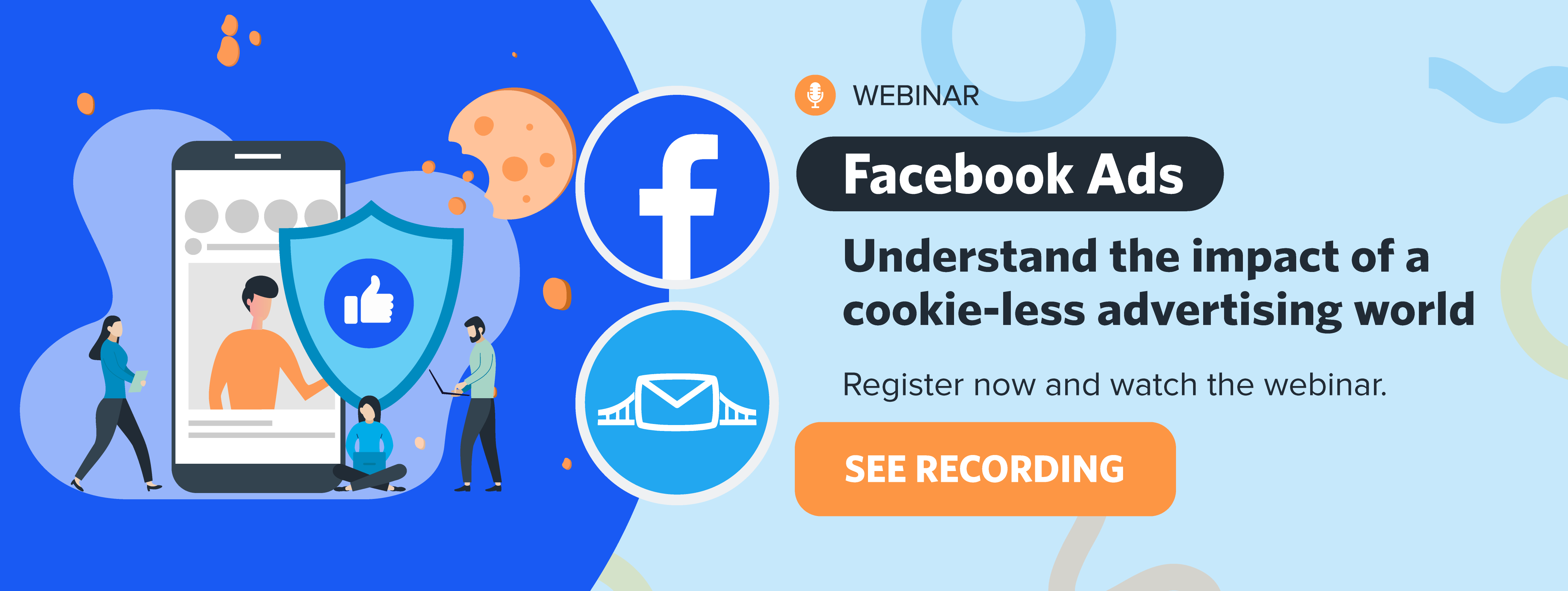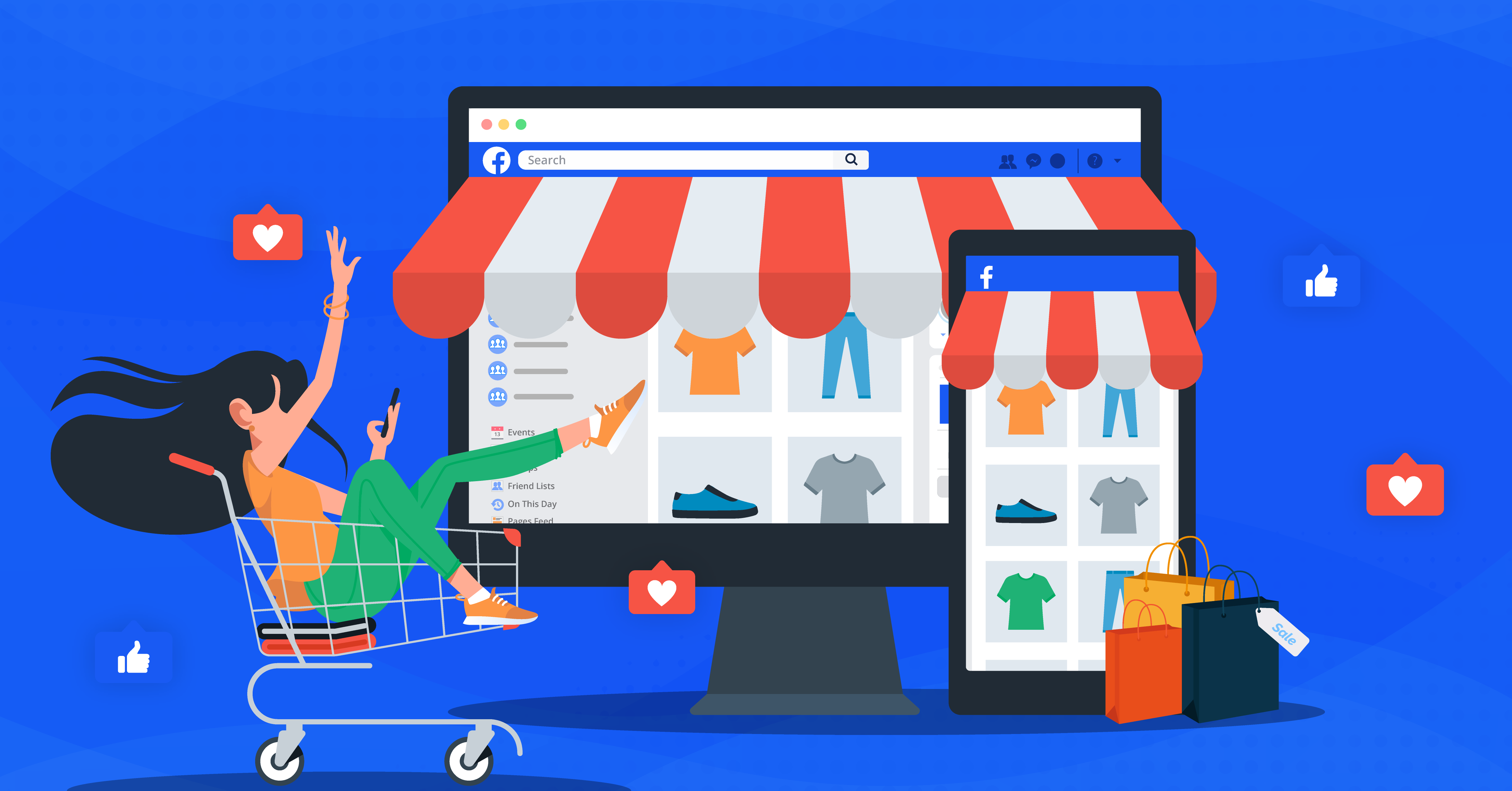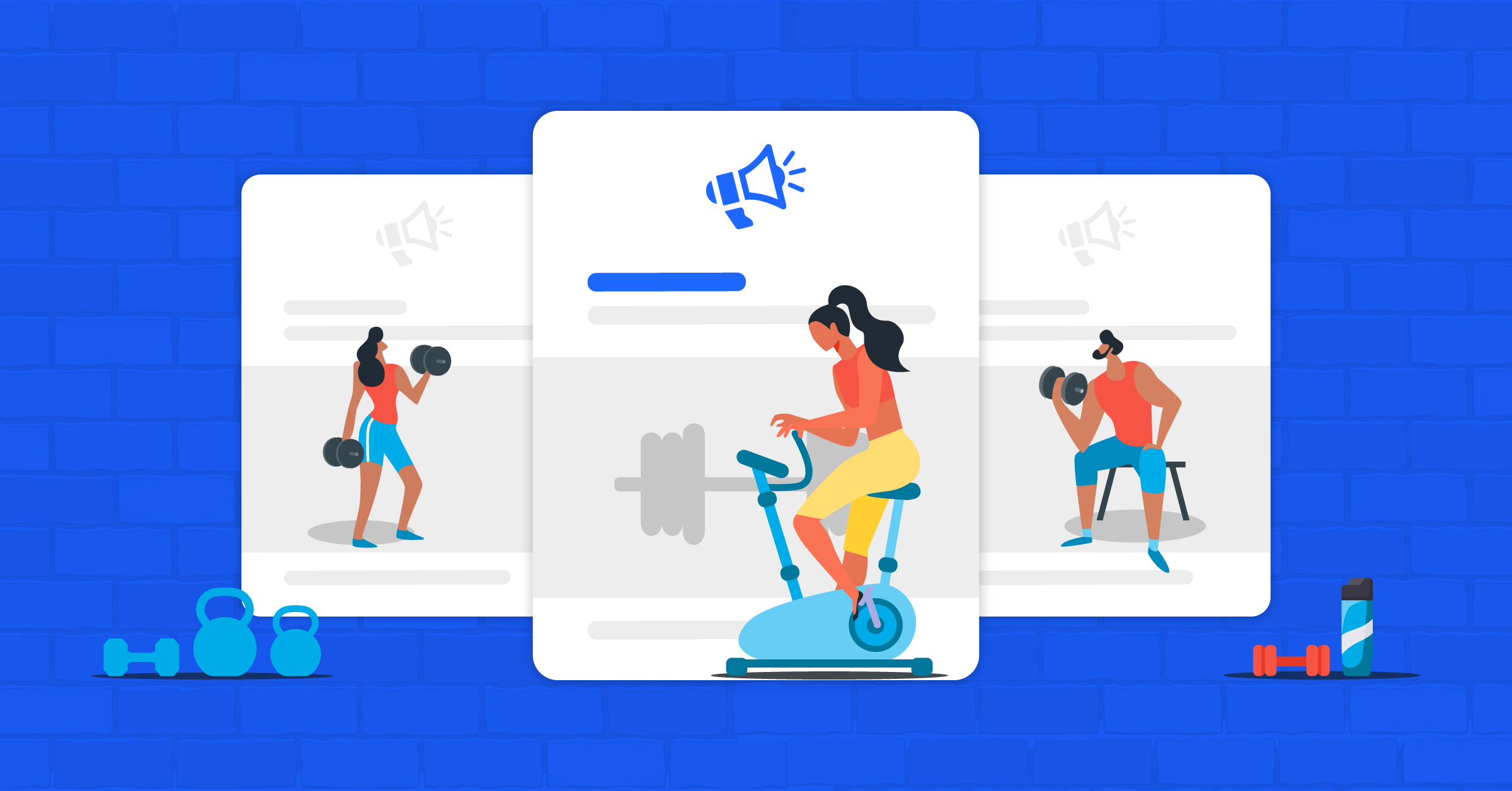
Ads across Meta technologies are a fantastic tool for your business’s social media marketing. With 11 original ad objectives (6 simplified ones), 8 ad formats, and 4 main targeting options, the platform lets you create highly customized and targeted campaigns.
Mastering these features boosts your fitness and health gym ads while allowing you to run multiple successful campaigns effortlessly.
In this article, you’ll learn all about Ads across Meta technologies for gyms and how LeadsBridge can help you turbocharge your marketing workflows using automation.
Benefits of Facebook Ads for gyms
If you are thinking about advertising your gym, Facebook can be a game-changer. Consider this: there are over 16 million audiences on Facebook with an interest in Exercise equipment. While some of these people follow a do-it-at-home principle, others are gym-goers.
That’s why Meta Ads for gyms offer many benefits.
- Laser-sharp audience targeting using specific demographics, interests, and behaviors. This ensures that your ads are shown to interested individuals.
- Large audience reach (3.03 billion monthly users) that lets gyms tap into this massive user pool to increase brand awareness and conversions.
- Cost-effective advertising, even with a budget as modest as $100; Facebook allows you to run basic yet effective gym ad campaigns.
- Creativity for better performance and offering engaging visuals and persuasive copy that easily captures the attention of users scrolling through their feeds.
- Detailed analytics and insights, like clicks, impressions, and conversions, allow you to assess the effectiveness of your campaigns.
- Community-building abilities using content, such as workout tips, success stories, and community events, can foster a loyal following.
- Tapping into mobile-friendly usage to offer ads that are visually appealing and user-friendly across different screens.
- Accessing retargeting opportunities: Clickthrough rates for retargeting ads are ten times higher than normal ads. Facebook allows you to implement retargeting strategies and re-engage users who have interacted with your ads or website.
How to get results for gyms with Facebook Ads
Understanding your audience extends to the digital realm where mastering fitness hashtags can significantly improve the visibility and engagement of your gym’s social media posts. Wondering how to get results for gyms with Meta Ads?
Here are some best practices that help you effectively target your audience and create ads that convert:
Define your target audience & buyer persona
Who are your ideal customers? You want to target them granularly: consider demographics, interests, behaviors, and any other relevant factors.
Then, use Facebook’s audience targeting options to narrow down your audience based on the factors you’ve defined.
Understand your audience’s pain points & interests
What challenges do these audiences face, and how can your gym address them? Having different audience segments helps you create content and messaging that offers solutions that appeal explicitly to the audience you are targeting.
Study your competitors’ ad strategies
What types of ads your competitors are running? Identifying what seems to be working for them helps you optimize your ads.
Don’t overlook Facebook Audience Insights
Facebook’s Audience Insights tool gathers information about your target audience’s demographics, interests, and behaviors. This data broadcasts your ad targeting and content strategy to create high-performing ad campaigns.
Optimize for Ad Placements across Meta technologies (Facebook & Instagram)
Do you know where your audience is most active on Facebook (e.g., News Feed, Instagram stories)? Facebook’s Conversions Leads tool helps you find out.
Monitor, test, iterate, & improve
Use analytics tools to track key metrics like click-through rates, conversion rates, and return on ad spend.
Then, based on the performance data, continue to optimize your ads. Create multiple ad variations and test to see which combinations perform the best.
Remember, no matter your advertising strategy, you’ll need to stay aligned with Meta’s Personal Health and Appearance advertising policy. Otherwise, your ads might not get approved or get removed after publication.
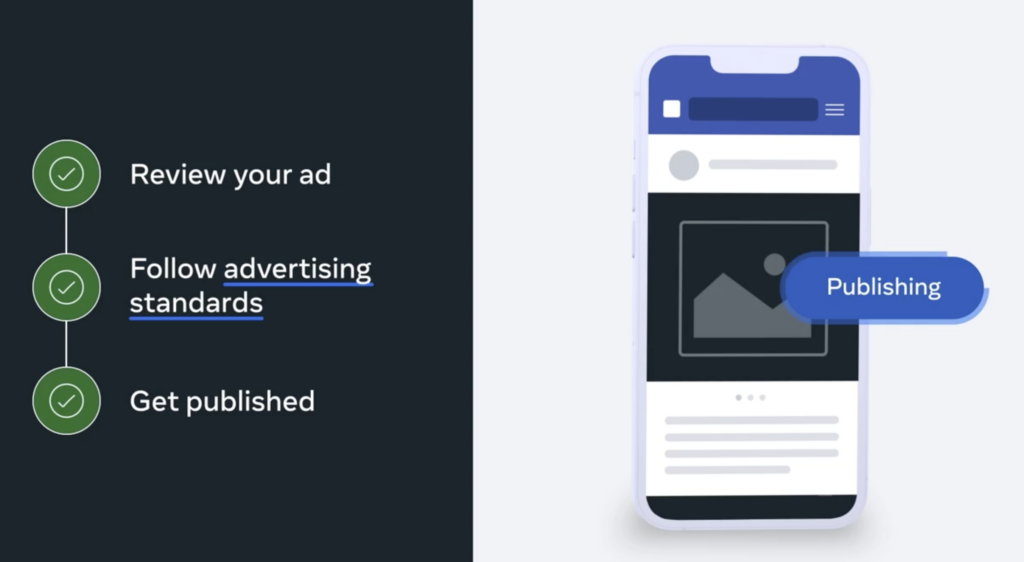
Types of Meta Ads’ objectives
Facebook tailors ads to users’ preferences by showing personalized content based on their interests. This way, your ads can reach individuals who’ve shown interest in your product/services.
Meta Ads objectives are designed to help target your gym ads more effectively toward the desired audience. Think of each objective as a way to focus on users at different stages of the sales process.
However, you’ll need to orchestrate your campaigns by using these objectives in multiple campaigns. The simplified objective categories include:
- Awareness
- Traffic
- Engagement
- Leads
- App Promotion
- Sales
1. Awareness
- Goal: Increase visibility and familiarity with your brand.
- Use Case: Best for new businesses or existing brands launching a new gym membership offer or service.
2. Traffic
- Goal: Drive more people to visit a website or an app.
- Use Case: Effective when you want to increase the number of visitors to the site or app.
3. Engagement
- Goal: Drive impressions such as likes, comments, and shares.
- Use Case: Useful for increasing social media presence and community building.
4. Leads
- Goal: Collect data (like names and email addresses) from potential clients.
- Use Case: Great for businesses aiming to build a mailing list or generate leads.
5. App Promotion
- Goal: Boosts installations and interactions with a mobile app.
- Use Case: Ideal for businesses with a mobile app that aim to drive downloads and user engagement.
6. Sales
- Goal: Increases conversions and product or service sales.
- Use Case: Ideal for businesses looking to generate revenue directly through their Meta Ads.
Meta Ads formats
Using specific ads across Meta technologies (Facebook & Instagram) formats helps your business share all sorts of info with your audience. Additionally, they help optimize ad delivery and performance based on the desired outcome.
For example, gym ads should catch attention, share the necessary details, and drive engagement. Using the right format not only helps you achieve your target but also makes your brand memorable.
Photo ad format
The photo ad format enables businesses to design advertising content that combines an image with a call-to-action, a short description, and a title. Make sure your images are aligned with Meta’s official guide by keeping the text in pictures lower than 20% for better performance.
The image ads format enables businesses to design advertising content that combines an image with a call-to-action, a short description, and a title. It is worth noting that according to Meta’s official guide, you should keep the text in pictures lower than 20% in order to yield better performance.
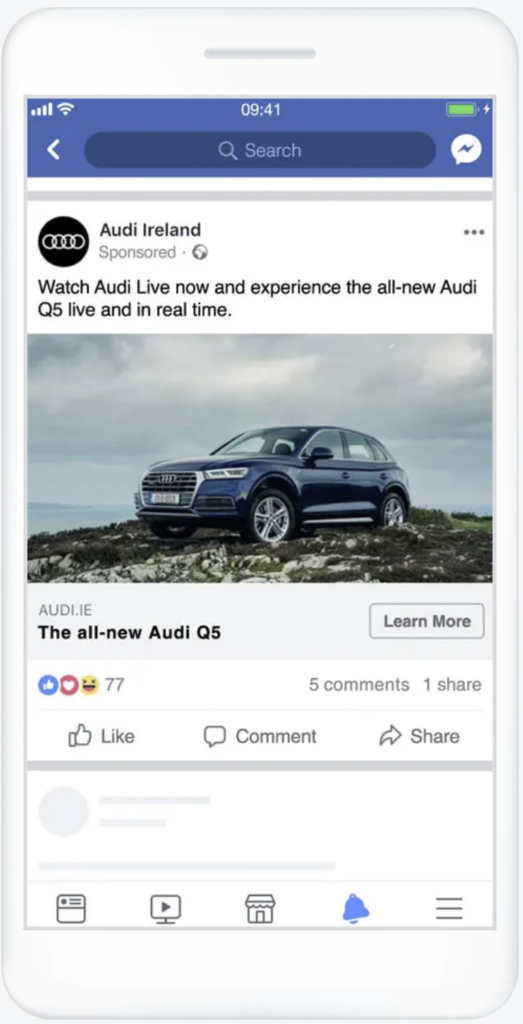
Facebook mentions that photo-only ads are superior in driving unique traffic. This format lets you create a quick photo ad directly from your Facebook Page by publishing and boosting a post with an image. They are ideal for making tangible products stand out and boost awareness.
Here are some guidelines to consider:
Design specs:
- File Type: JPG or PNG
- Ratio: 1.91:1 to 1:1
- Resolution: Minimum 1080 x 1080 pixels
Text limits:
- Primary Text: Up to 125 characters
- Headline: Up to 27 characters
- Description: Up to 27 characters
Technical details:
- Max File Size: 30 MB
- Min Width: 600 pixels
- Min Height: 600 pixels
- Aspect Ratio Tolerance: 3%
Looking for an example of Facebook Ads for gyms using photo format?
Here’s an ad by Gym and Fitness showcasing the freeform ski trainer, which the brand informs users is in stock and available for purchase.
The second example, by Jordan Fitness, informs users that the brand is offering a 55% discount promotional campaign. The ad targets gym-goers who want to purchase their own equipment for at-home use.
Both ads feature the products that the companies are trying to highlight and provide a link to their respective product page. The simplicity and direct targeting are what make these kinds of gym ads successful. As you can see, the images do not contain any additional text.
Video ad format
According to Statista, digital video advertising spending in the U.S. will increase to 78.5 billion. Why is such a massive capital dedicated to this ad format? Because they get watched!
Video ads boost brand visibility with short, engaging clips that prompt user action, like page likes or product purchases. This format is ideal for sharing your business story or customer journey.
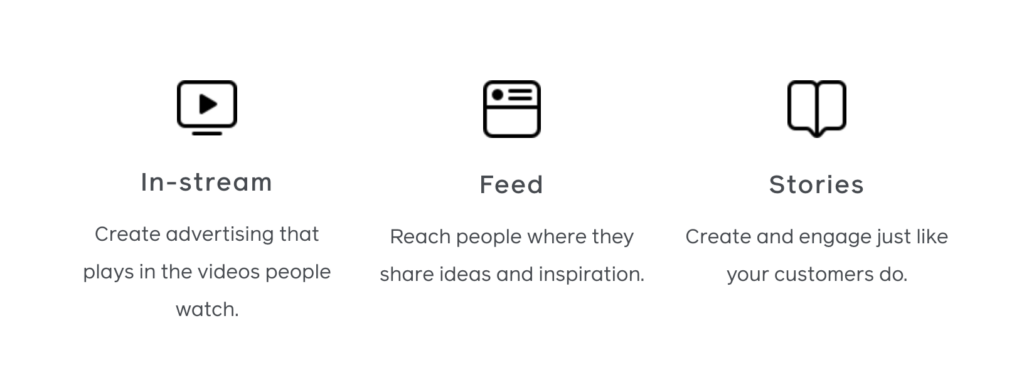
These brief videos, whether showcasing products or testimonials, convey your brand’s essence. Adding a link or call-to-action enhances engagement and conversions, allowing viewers to pause, absorb, and evaluate your gym business offerings.
The official guideline recommendations for video ads include:
Video specs:
- File Types: MP4, MOV, or GIF
- Ratios: 1:1 (desktop or mobile) or 4:5 (mobile only)
- Settings: H.264 compression, 1080 x 1080 pixels, optional captions, optional sound, no edit lists or special boxes
Text limits:
- Primary Text: 125 characters
- Headline: 27 characters
- Description: 27 characters
Technical details:
- Duration: 1 sec to 241 min
- Max File Size: 4 GB
- Min Width: 120 pixels
- Min Height: 120 pixels
Bonus:
- 360 Videos: Explore every angle with interactive 360-degree ads.
Let’s take a look at an example of Facebook gym ads with video format. BodyBoss Portable Gym 2.0 teaches its users how to correctly use this particular piece of equipment, the muscle group it targets, and how they can purchase it. To top that up, they have included a special 30% discount.
Life Fitness used video ads to promote their English and Spanish Studio Coach workouts available within their app. Additionally, they have enlisted the benefits of these to users and a free two-week trial for those who do not already have the app installed.
These gym ads examples show how to deliver a point to audiences in an articulated and brief manner. Both offer a balanced text-video combination that makes the viewer consider using your products and services.
Carousel ad format
Carousel ads feature multiple images or videos in a scrollable format, each with a call-to-action. You can seamlessly blend various sales objectives, starting with awareness, showcasing products, and concluding with a compelling final pitch.
These ads are best for presenting multiple products or packages. Businesses like fitness centers use carousels to granularly highlight their offerings.

As the guideline suggests, these ads should have:
Carousel specs:
- Image Types: JPG or PNG
- Video Types: MP4, MOV, or GIF
- Ratio: 1:1
- Resolution: Minimum 1080 x 1080 pixels
Text limits:
- Primary Text: 125 characters
- Headline: 32 characters
- Description: 18 characters
- Landing Page URL: Required
Technical details:
- Cards: 2 to 10
- Image Max Size: 30 MB
- Video Max Size: 4 GB
- Video Duration: 1 sec to 240 min
- Aspect Ratio Tolerance: 3%
Now, let’s take a look at some examples of Facebook gym ads using carousel format. Jordan Fitness uses this format to highlight multiple pieces of equipment included in their 50% discount promotion.
In the next example, Titan Fitness showcases its vertical leg press by including a more in-depth view of each component of the equipment.
These types of gym ads provide several compelling options to the viewer and engage them with interactive features. They combine the product listing with a video description, giving viewers a chance to study the products in more detail.
Stories ad format
Stories ad format is a dynamic way to connect to your audience. Authentic and engaging stories develop closer connections while being inclusive. About 57% of viewers have said that the Facebook Stories make them feel part of a broader community.
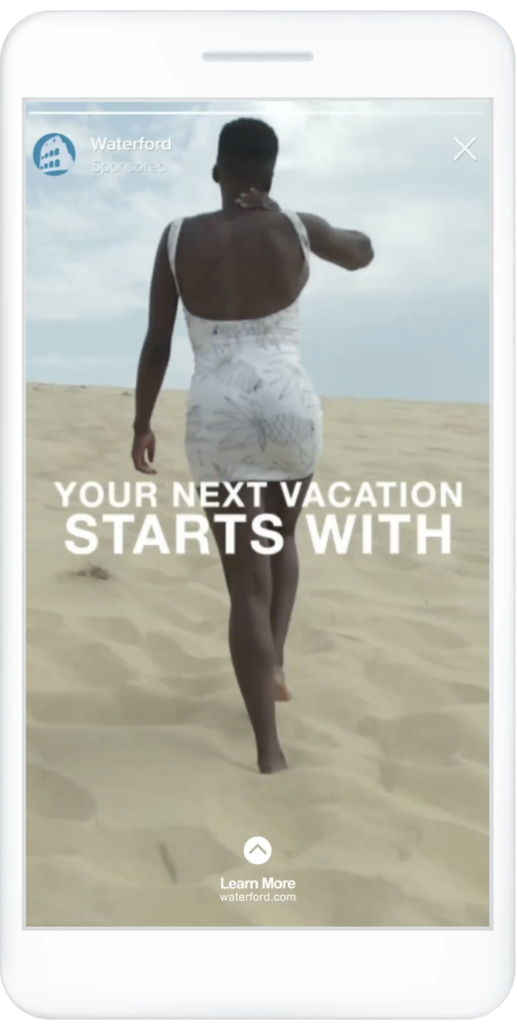
This format is also more compatible with phone interactions. Mostly because they’re designed for a natural, vertical, full-screen view.
According to the guidelines, you should format your stories as shown below:
Design recommendations:
- File Types: MP4, MOV, or GIF
- Ratio: 9:16
- Settings: H.264 compression, 1080 x 1080 pixels, optional captions, optional sound
- Free Space: Keep 14% (top) and 20% (bottom) clear to avoid UI overlap.
Text limits:
- Primary Text: 125 characters
- Headline: 40 characters
Technical details:
- Duration: 1 sec to 2 min
- Max File Size: 4 GB
- Min Width: 500 pixels
- Aspect Ratio Tolerance: 1%
Here’s an example of a fitness ad using the Story format. Kerim Workouts has created a brief video to showcase a routine with flair—add movement and sound for a quick attention grabber.
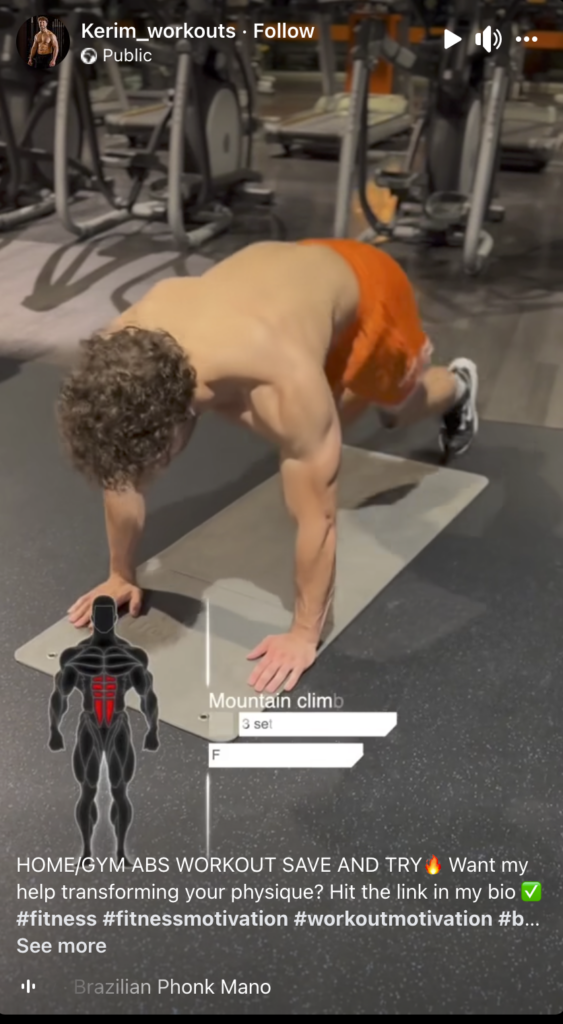
This ad highlights a unique workout routine that also narrates the brand story creatively. All while providing value to the audience through instructions.
Messenger ad format
Messenger ads let you reach more people right in their Messenger app inbox. While taking advantage of Messenger’s global reach of 1.3 billion monthly users, it lets you use the same creative approach available on Facebook and Instagram.
When users tap on your ad in the Chats tab, they get sent to a detailed view in Messenger. Then, they can easily connect with your business or head to your site or app.
There are two Messenger ad options:
1. Ads in Messenger Inbox that appear between conversations. Clicking on these ads directs users to a detailed view with a CTA button.
- Delivery: They are automated for optimal campaign results.
- Targeting: It lets you leverage user profiles, Pages, groups, and connections on Facebook and Instagram.

Note: This option is currently unavailable in the US, Canada, Australia, and France.
2. Ads in Messenger Stories: These ads appear between organic stories. They are designed to boost your Instagram and Facebook Stories campaigns.
When it comes to recommended guidelines, you’ll need to follow specs and technical instructions for photo ads, video ads, or carousel ads. This depends on the creatives you select for your messenger ads.
Here’s a hypothetical example of a messenger ad for gyms, offering a workout routine.
Using automation, the ad targets users who want a personalized workout routine. The interactive communication makes the ad engaging and practical to its audiences.
Slideshow ad format
Slideshow ads offer a cost-effective way to create impact with captivating visuals and narratives. They work like video ads, while they are made of a series of photos. However, you can seamlessly integrate motion, sound, and text to tell compelling stories across various devices.
Compared to video ads, they have swifter loading times, even on slower connection speeds. You can also use stock footage and music to create the slideshows in no time.
That’s why Slideshow ads are an ideal choice for those wanting to offer immersive experiences without spending much on traditional videos.
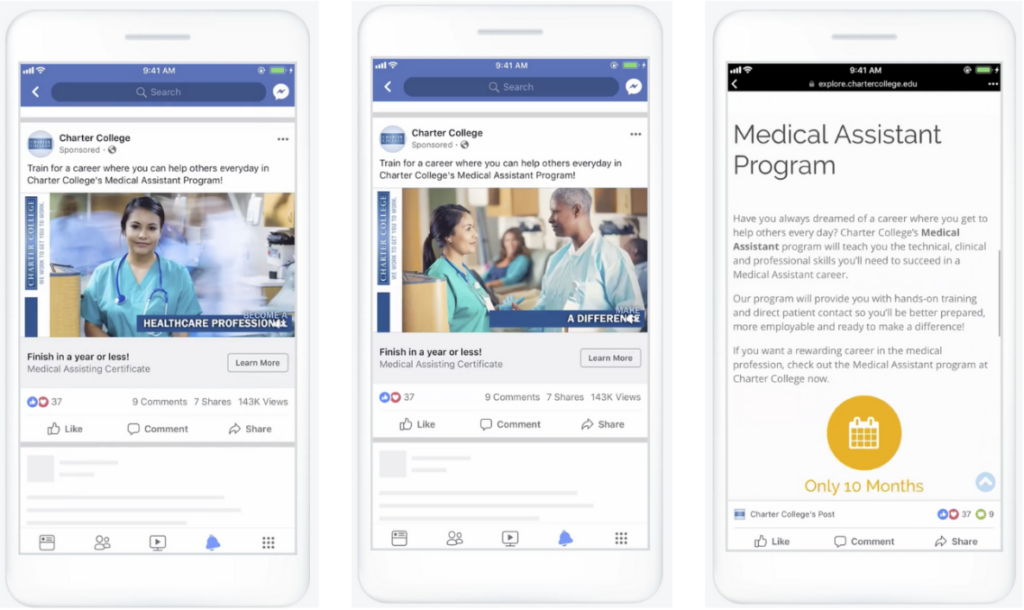
You can use 2-15 images for your slideshow. However, the selected images need to be in any of the supported formats given in Meta’s guidelines here and follow the rest of the instructions for photo ad format.
Check out this Facebook gym ad in Slideshow format!
It features moving, animated images, creating a dynamic experience that successfully conveys a sense of the session itself. With faster loading times than video, it tells a compelling story to its audience while keeping them engaged.
Collection ad format
The Collection ads are designed for a single purpose: to simplify the journey from product discovery to purchase. They are especially suitable for mobile users who often initiate product exploration through videos.
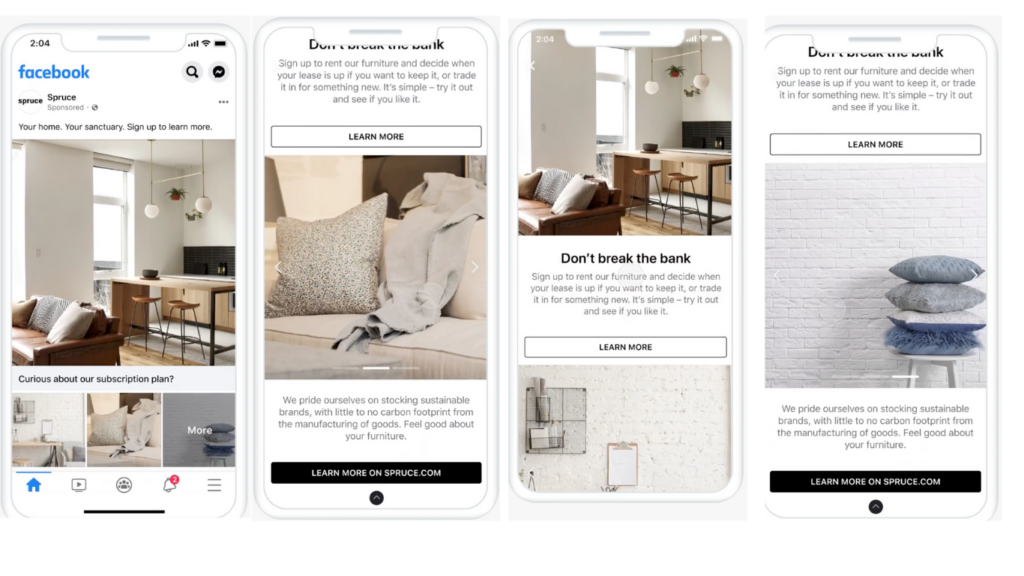
This format integrates a primary video or image with three smaller accompanying images in a grid-like layout. When users tap on the ad, they seamlessly transition to a fast-loading visual experience powered by Instant Experience, all within the Facebook or Instagram environment.
The Collection format provides different templates that you can choose based on your specific marketing goals. For instance, the Instant Storefront template is ideal for showcasing a catalog of products in a grid, while the Instant Lookbook template is suitable for demonstrating products in action.
Here are the guidelines to follow when creating a collection ad:
Collection ad specs:
- Cover: Uses first media from Instant Experience.
- Image/Video: JPG, PNG, MP4, MOV, or GIF; 1:1 ratio; 1080 x 1080 pixels.
- Text: Primary 125 characters, headline 40 characters, required landing page URL.
- Tech: Instant Experience required, image max 30 MB, video max 4 GB.
Playable ad format
Playable ads are essentially interactive video ads that provide a try-before-you-buy experience. This means your users can preview the app’s features through a lead-in video in News Feed or Stories.
Prospective users test-drive the app directly from the ad, while advertisers discover engaged players or customers with higher intent. They could be a lead-in video, an interactive game demo, and a call to action for app installation. Either way, playable ads serve as a digital test drive for apps.
Here are the specifications for playable ads:
- HTML5 Assets:
- HTML format, <2MB, no mraid.js, no HTTP requests, portrait mode, responsive design.
- Single file, data URI compressed, use FbPlayableAd.onCTAClick() for call to action.
- No JavaScript redirects, no dynamic external asset loading.
- Combine into one file: encode the image into base64 string, integrate js into index.html.
- Zip Files:
- Supported on iOS and Android, <5MB, <100 files.
- Zip archive with index.html at the root.
- Lead-in Video:
- All aspect ratios supported (Landscape, Square, Vertical).
- Required for playable ads, delivered in News Feed only, not on Audience Network placements.
Lead ads & creative formats
Lead ads across Meta technologies (Facebook & Instagram) can appear in Facebook Feed and Stories, Instagram Feed and Stories, Instant Articles, in-stream videos, Marketplace and anywhere else Meta ads can be.
A lead ad is made two units: a creative ad unit (image or video) and an instant form. They are designed to allow users to seamlessly generate new leads by creating a shortcut in the subscription process.
As a result, your audience can submit pre-filled forms that are populated with their information, which is derived from their Facebook profile.
This also means people don’t have to manually fill out each entry form. Users only need to provide specific details, streamlining the submission process for effective lead generation.
To create high-quality leads in a short amount of time, you’ll need to get help from automation. After integrating lead ads with your CRMs, you can automatically sync data between your Facebook and your database.
Check out the different integrations for Meta lead ads:
Here are the creative specifications for designing an optimized lead ad:
- Images: JPG or PNG, 1,080 x 1,080 pixels, 1:1 ratio, Text: 125 characters, Headline: 40 characters, Description: 30 characters.
- Videos: MP4 or MOV, up to 15 seconds, 4:5 ratio, H.264 compression, Text: 125 characters, Headline: 40 characters. The optimal video length is 15 seconds, but can be up to 240 minutes (shorter is often better).
Facebook gym ads: Advertising fitness classes
Let’s review some lead ads across Meta technologies in action.
Our first example is from a campaign by Fisique Boston. This health & fitness club wanted to grow the number of its membership subscriptions. Using LeadsBridge CRM integrations paired with Facebook lead ads and custom audiences, they generated an ROI of 21x on a total investment of $265.
It’s also effective to connect your gym promotion with broader wellness topics. A campaign dealing with overall health concepts like diet plans or safe use of supplements such as Metformin for weight management could attract a wider audience.
“The results were extraordinary, and now we’re splitting into more campaigns.”
Eugene Mann – Founder of PPL Labs
Discover more statistics and information about Fisique Boston’s campaign here.
Another example is by Inishowen Gateway Hotel Gym. They published their entire schedule using the single image format.
Similarly, Fisique uses the single image format. Instead, it uses a sign-up form attached, to advertise a six-week transformation available to 25 women.
Our last example is by Elevate Fitness & Performance. It uses a carousel format to advertise its 90-day nutrition program, including a call to action to send the brand a message to discover more information.
As you can see in these ads, the carousel format, and single image format are equally effective when used properly. Once clicked, the links attached to these gym ads redirect the user to the lead ads option, which helps them to move more leads and customers down the funnel.
Want to get the most out of your ad campaigns? The right tools play an important part.
Check out our top picks of the best free marketing tools.
Supported CRM integrations for lead ads across Meta technologies (Facebook & Instagram)
An official list of supported CRMs can be viewed here. Find out more information about how to integrate Facebook lead ads with LeadsBridge here.
Other examples of Facebook Gym Ads
A positive example of health and fitness advertisements
Effective fitness ads strike the right tone, composition, and color to inspire people. They combine copy with elements like images and headlines that have been carefully crafted.
It’s important that they avoid being misleading or making false claims. For instance, an ad promoting body confidence exemplifies positive health and fitness advertising without resorting to falsehoods.
Take a look at how Lane Bryant achieved this:
Here’s another example of health and fitness advertisements that positively impact the end-receiver.
Blink Fitness redefines fitness ads by promoting an inclusive and achievable approach, focusing on feeling good rather than physical appearance with their “Mood Above Muscle” campaign.
In 2016, they invited Instagram followers to share confidence stories for a chance to be part of the campaign. From 2,000 submissions, 50 semi-finalists were auditioned by a celebrity panel.
Then, they selected 16 individuals representing diverse shapes, sizes, and fitness abilities. This initiative goes beyond typical fitness ads, taking a stand against unrealistic body standards and advocating the belief that “The best body is your body.”
A negative example of health and fitness advertisements
It’s common that in health and fitness, negative ads, especially for weight loss, brands often promise unrealistic results. Some companies resort to misleading tactics in their fitness ads to pressure people into joining their clubs.
Here is an example of a negative fitness advertisement from Reebok’s Easytone shoes. The company created a series of ads for the Easytone and RunTone shoes in 2009 and 2010, claiming that Tone shoes could work the hamstrings and calves muscles to become up to 11% harder and tone your butt up to 28% more than regular sneakers.
While the shoes forced you to use more muscles when you moved, the FTC investigation found that the EasyTone shoes make walking uncomfortable. So, Reebok had to refund over $25 million in purchases.
You can find one of their ads below.
Another negative example of health and fitness advertisements. VitaminWater marketed its product as a healthy alternative to soda, while the drink was actually made with large amounts of sugar.
The marketing tagline was “vitamins + water = all you need”, which relied on inaccurate messaging. It hides the fact that each bottle contained an unhealthy dose of eight teaspoons of sugar.
The Center for Science in the Public Interest investigated the product and discovered the company’s false claim, as is the case with other negative fitness advertisements. VitaminWater was requested to add “with sweeteners” to its labelling.
The above examples should provide enough insights and what negative fitness advertisements look like and what to avoid.
The workout ad
Take a look at the workout ad above by BodyBoss Method. This marketing tips for gym shows that people have a good time if they join this brand’s fitness classes. The copy is transparent in conveying the message, and the call to action prompts the viewers to interact with the advertisement.
Looking for more Meta Ad examples? Get inspired by these 20 high-performing Meta lead ads examples.
Facebook Ads for CrossFit gyms
Functional movements that imitate daily activities are a hallmark of CrossFit workouts, which are frequently done at a high level of intensity.
CrossFit gyms have a dynamic medium to interact with their target audience through Facebook marketing. Gyms may connect with people who are passionate about challenging workouts and group fitness with specific targeting possibilities.
Testimonials establish credibility, and visual content, particularly videos, can show the typical routine and environment of CrossFit. Gyms, in turn, can fine-tune their plan for optimum engagement and conversions by using Facebook’s data.
One of the great examples of Facebook Ads for CrossFit gyms by World Gym Burpengary:
This ad stands out by clearly offering a free 5-day trial from the start. With it’s a trial, the ads’ straightforward copy and content convey the offer.
Gym membership ads
Meta Ads are a powerful tool for gyms to highlight the advantages of membership. The visual appeal shows the resources, tools, and what the members can gain from it.
These ads could also have limited-time deals to create a sense of urgency and entice new members with special offers and benefits. A high-performing tactic is incorporating user-generated content since it provides credibility.
When creating a gym membership ad, you may also optimize your campaigns through routine performance monitoring, recruiting, and keeping a committed membership base.
Check out this gym membership ad:
Facebook users are drawn to giveaways, and when executed effectively, they become a powerful lead generation tool for gyms. Fernwood Fitness demonstrates this well with clear and concise ad copy while making it easy for users to understand the offer.
Facebook ad gym special offer
Special offers are one of the go-to advertising strategies. The following Facebook ad from Gold’s Gym is all about their special offer for Father’s Day.
Let’s break down the copy elements in this Facebook ad gym special offer:
- Celebrate Father’s day: It’s encouraging people to give the gift of health and strength.
- No enrollment fee: The subscriber can join the gym without paying any signup fees.
- No contract: It doesn’t call for a long-term commitment.
- Who it’s for: Whether for a dad wanting to get fit or a child giving this as a gift to a dad.
The ad is a straightforward and attractive deal for anyone interested in improving their fitness.
Facebook Ads for personal trainers
Not only is Facebook one of the best platforms to use for growing and scaling your business quickly and efficiently. When creating your Facebook gym ads, there are some best practices that you are recommended to follow.
These include:
- Selecting a suitable image
- Using a headline to draw attention to your copy
- Keep everything as simple as possible
- Add your “hooks” to the mix
- Upgrade your system with automated marketing tools
For personal trainer ads, tool choice is crucial. Keeping CRMs and data management workflows can be daunting tasks. However, integrating third-party tools like LeadsBridge can revolutionize your data system functionality. Also, you’ll get to automate tasks, increase your campaigns’ efficiency, and streamline your business operations.
LeadsBridge offers a Free Forever Plan, where you can test these integrations and discover benefits of workflow automation benefits before upgrading to paid plans. Discover more about LeadsBridge’s free and paid plans in detail.
Facebook offers a quick ad setup, enabling a personal training campaign in under 30 minutes. Concerned about the costs? Learn everything you need to know about online ad costs here.
The average cost for a gym lead on Facebook ad
Getting leads for your gym through Facebook ads can cost anywhere from $5 to $20 per lead. The price depends on:
- Who you’re targeting;
- How good your ad is;
- And how many other businesses are competing for the same audience.
To keep costs down, make sure you’re reaching the right people, create engaging ads, and set a budget that works for you. By doing this, you can get more leads for your money and see better results from your ad campaigns.
How to advertise personal training on Facebook & Instagram
Here’s the step-by-step guide for advertising personal training on Facebook and Instagram.
1. Create advertising goals
First, define your ad purpose. You may be building an email list, getting requests for free sessions, or acquiring clients. In any case, always maintain a single goal per ad. For example, design an ad specifically for email list subscriptions. However, you can use separate campaigns to nurture prospects into clients.
2. Define your offer
Next, decide on compelling offers for ad clicks—like an Ebook, checklists, free sessions, or a 7-day pass. Solve your audience’s pressing needs with genuine value. Vision Personal Training sets an excellent example with its fitness class ads.
3. Create a custom audience
For Facebook personal training ads, create a custom audience of past engagements. For instance, target users who’ve watched your videos, ensuring a pre-existing interest. Need help with custom audiences?
Check out this step-by-step guide to custom audiences.
4. Use a catchy headline, image, and CTA
In gym ads, compelling headlines that address user needs get noticed. For instance, target California students with a headline like “Attention California Students” for the student loan niche.
Always choose standout images with the right background and run A/B tests for optimal performance. Lastly, make sure to have an attractive Call to Action button for more clicks.
5. Use the right ad
Meta lead ads are the best way to collect leads for your personal training business. It keeps the user on the platform when filling out the form. This reduces friction, leading to higher engagement rates.
6. Connect your lead ads across Meta technologies to your CRM or Autoresponder
After generating leads from Facebook or Instagram, you’ll need to transfer data to your CRM using manual, API, or third-party methods. Manual downloading is time-consuming and prone to errors. The API method is secure but complex, especially for non-tech users.
The most single efficient way is through a third-party platform, like LeadsBridge. Using automated data bridges, LeadsBridge enables you to seamlessly connect your CRM to Facebook or Instagram and keep your database always updated.
Automatically syncing your lead data into your CRM saves you both time and effort. It also ensures timely nurturing. For instance, you can send the promised offer before your leads lose interest.
Discover the best lead ads integrations for your campaigns.
7. Test, test, and test
Test your gym ads continuously to see which are performing the best. Once you have collected enough data, use them to optimize your existing or future campaigns and get better results.
Learn how to create high-converting B2B Meta ads here.
LeadsBridge integration for health and fitness advertisements
Let’s check out some of the most effective integrations to use for automating the lead generation process. These data bridges allow you to streamline workflows throughout the entire sales funnel.
LeadsBridge integrations with Mindbody app
The Mindbody app connects users with local fitness, beauty, and health businesses for bookings and subscriptions. LeadsBridge integrations for Minbody help streamline workflows for health and fitness brands using the app.
Automation also leads to better customer satisfaction and ROI. Connect Mindbody to autoresponders, CRMs, and other tools effortlessly.
These integrations also allow you to build new email notifications, sync custom audiences, update subscriber lists, and more for leads from the Mindbody app.
Want to know more about Mindbody and Facebook integrations? Here are some valuable reads:
- How to connect Facebook lead ads to MindBody through LeadsBridge.
- How to use Mindbody with Facebook Ads.
- Our Mindbody app review.
- And all other LeadsBridge integrations for your gym & fitness business.
LeadsBridge integrations with Clickfunnels
For coaches and trainers, balancing existing clients and attracting new ones can be challenging. Manual lead management wouldn’t be enough in today’s highly competitive market. On the other hand, stats indicate a 451% increase in qualified leads with marketing automation. Here’s how Clickfunnels for coaches can help automate your lead generation efforts.
Discover all other LeadsBridge integrations for your gym & fitness business.
Other Leadsbridge integrations for Facebook Ads
Facebook custom audiences
Facebook offers precision targeting tools such as custom audiences and Lookalike Audiences. These advertising features allow you to refine audience selection based on demographics, location, interests, and behaviors.
You can then add a layer of granularity to your audience segments by including parameters like age, gender, relationship status, education, job role, and more. That’s where custom audiences come into play.
For businesses in health and fitness, custom audiences leverage existing customer lists to promote new offerings directly on Facebook Feeds to maximize engagement and awareness.
Lookalike Audiences
On the other hand, Lookalike Audiences use the characteristics of your existing audience to create audience lists that look like your customers in terms of interests and behaviors. Then, you can target these users with ads relevant to them. The smaller the audience size, the better your precision.
Learn more about Lookalike Audiences and how to use them.
Conversions API for CRM
Conversions API for CRM fosters both better data privacy and personalized advertising for businesses targeting mid-to-lower funnel audiences. This tool ensures accurate data sharing and is immune to browser crashes or ad blockers.
Conversions API for CRM gives you control over shared data and the ability to choose what and when to share alongside Pixel tracking for full-funnel visibility. This means a broader range of data to support advertising efforts, including tracking events such as leads, purchases, form submissions, and more. Learn more about Conversions API for CRM here.
What’s more, you’ll need to integrate Conversions API for CRM using LeadsBridge to streamline data transfer workflows.
Conversion leads performance goal
The leads conversion performance goal is a valuable feature tailored for Meta lead ads to optimize ad delivery. It essentially prioritizes users likely to become high-quality customers.
By selecting the Conversion leads performance goal, you instruct Facebook to target users who are more likely to convert. Then, the odds of turning leads into customers increase significantly.
Connecting your CRM with Facebook allows you to get the most out of this feature. Using LeadsBridge, you can build these integrations and, in turn, help Meta analyze data from your CRM. This way, the platform can identify and target audiences similar to your existing customers.
Please note that for this integration to work, you should first have a running Meta lead ads campaign and have implemented Conversions API for CRM in advance.
Final thoughts
Creating awareness and spreading the word about a health & fitness business means generating more potential leads and customers. Running gym ads using Facebook can result in significant and long-term gains when partnered with a strong strategy and the right tools.
As an official Meta partner, LeadsBridge specializes in all-things-Facebook. You can find all extensive guides, announcements, tools introductions, and more on the LeadsBridge Resources page.
Explore what LeadsBridge has to offer for streamlining your gym & fitness management.



